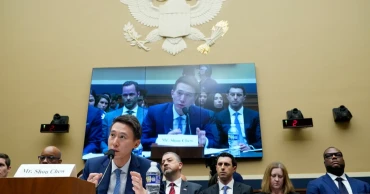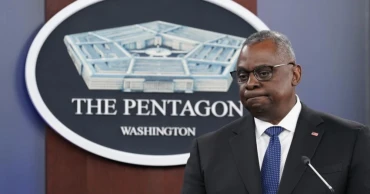threat
Cybercrime through social media: A growing threat in Bangladesh
The rapid evolution of technology has allowed everyone access to an unprecedented world of knowledge, but it has also paved the way for a rise in network-based crimes, or cybercrimes, many of which are centered around the internet.
In Bangladesh, social media platforms like Facebook, Instagram and Telegram have become increasingly instrumental in facilitating criminal activities, ranging from identity theft and fraud to online gambling and blackmail.
As more people turn to the internet for communication and business, criminals have seized the opportunity to exploit these platforms for nefarious purposes.
The most common cybercrimes in Bangladesh today include identity hacking, fake account creation, online multi-level marketing scams and gambling.
Blackmailing on Social Media
One of the most distressing types of cybercrime is blackmailing.
Shobha (not her real name), 25, experienced this firsthand when she was in a long-distance relationship with a man she met on Facebook. What began as friendly exchanges soon escalated into inappropriate requests for revealing photos during video calls.
Shobha, trusting the man, complied. But soon after, his behaviour took a dark turn. He began demanding large sums of money and when she refused, he threatened to publish her photos and videos online.
AI now capable of self-replication; scientists fear ‘red line’ crossed
The situation left her traumatised, but with the help of a senior mentor and the Cyber Crime Department in Bangladesh, Shobha was able to have the images removed from the man's account. However, the emotional scars of the incident remained long after.
Fraud Through Fake Facebook Pages
Another rampant issue is online fraud, particularly through fake Facebook pages. Anik (a pseudonym), for example, ordered a pair of branded shoes from a seemingly trustworthy Facebook page that featured glowing reviews and a large following.
The page required advance payment, which Anik made in good faith. However, weeks passed, and the shoes never arrived. Despite multiple attempts to contact the seller, Anik was left empty-handed and out of pocket.
Unfortunately, this is not an isolated incident—many victims fall prey to similar scams daily.
Honey Trap Targeting Young Men
Perhaps one of the most concerning cybercrimes that has gained traction in recent years is the “honey trap.”
Deputy Commissioner Md Najmul Islam, former Additional Deputy Commissioner of the Cyber Crime Department of Dhaka Metropolitan Police (DMP), explained that this scam typically begins on Facebook, then shifts to WhatsApp, where video calls are made.
The scammer, posing as a woman, will engage the victim in conversation and eventually ask them to make video calls in private settings like bathrooms.
The ultimate goal of the scam is to extort money by threatening to release compromising videos of the victim.
The perpetrators often operate from outside Bangladesh, with many cases originating from India.
The mental and emotional toll on victims has been devastating, with some driven to extreme measures, including suicide, due to the relentless blackmailing.
Trump signs executive order on developing artificial intelligence 'free from ideological bias'
Growing Online Gambling
In recent years, online gambling has become a dangerous addiction, especially among the youth in Bangladesh.
The lure of quick earnings, combined with the easy accessibility of gambling platforms via smartphones, has made it a serious problem.
Deputy Commissioner Shahjahan Hossain of the Cyber Crime Division of DMP pointed out that while laws to prevent public gambling exist, their enforcement remains weak.
“We lack specific legislation addressing cyber gambling. However, combating these issues is a priority under the government’s new initiatives,” he said.
The dangerous allure of online gambling is further exacerbated by the lack of regulation, which has led to widespread addiction and financial loss among young people.
Instagram: A Hotbed for Harassment
Social media platforms like Instagram have also become breeding grounds for cybercrimes.
Najmul Islam explained that one of the most common offenses on Instagram is cyberstalking. Perpetrators use the platform to harass individuals, sometimes by exploiting the personal information they find on victims' profiles to locate and intimidate them in real life.
Another prevalent crime on Instagram is fraud, where criminals use the platform to advertise fake products or services. These fraudulent ads often lead to significant financial losses for unsuspecting users.
Motive Behind Cybercrimes
The driving force behind most of these cybercrimes is the desire to make or extort money. Whether through blackmail, fraud, or online gambling, the perpetrators are motivated by financial gain, often at the expense of innocent individuals.
Top Free Prompt Engineering Courses Online in 2025
A Call for Tougher Laws
As these cybercrimes continue to escalate, experts are calling for stronger laws and more robust enforcement.
The government of Bangladesh has made strides in addressing cybercrime through new initiatives, but the complexity and ever-evolving nature of these crimes make it a constant battle.
Cybercrime may have its roots in technology, but its impact is very real—affecting victims emotionally, financially and psychologically, experts said.
As social media platforms continue to play a significant role in daily life, it is crucial for both the public and the authorities to remain vigilant and proactive in combating these modern-day crimes, sufferers said.
11 months ago
Teen gangs in Feni: A growing threat
The sprouting teen gangs have emerged as a major concern in the capital and other cities and towns of the country, and Feni town is no exception.
These misguided teens involved in theft, hijacking, drug abuse, stalking, sexual harassment, and murder, allegedly with the backing of local political leaders and public representatives, are now a new threat to society.
Locals allege that local political leaders patronize the teens to establish dominance, grab properties, and threaten opposition political activists.
2 killed in road crash in Gaibandha
‘Koshai’, ‘Himil’, ‘Shano’, ‘JK’, 'Pintu', and ‘Chakma Javed’ are among the 10 gangs of the district infamous for their crimes that have been extended even to the unions from the district town.
Talking to UNB, some guardians expressed their worries over the dreadful offenses committed by the teen gangs and the future of their children, as the deteriorating social environment due to the gang activities has made it difficult for them to keep their children aloof from their influence.
On Thursday, police arrested three ‘SDK’ group members, including their leader, for their involvement in various crimes, including the trade and buse of drugs, snatching, extortion, stalking, threatening people for extortion, showing arms, and clashing with rival groups.
Preferring anonymity, a SDK group member said,” If the ‘leaders’ need them, they inform the ‘big brother’ who completes the operations involving teen gang members, and they get money in exchange.”
A police official who preferred not to be named said if the teen gang members are arrested, they get phone calls from ‘big brothers’ or ‘leaders’ seeking their release.
School teacher beaten and harassed by police in Natore
1 year ago
G-7 envoys urge tough stance on Chinese, N Korean aggression
Top diplomats from the Group of Seven wealthy democracies are tackling two major worries in Northeast Asia, vowing a tough stance on China’s increasing threats to Taiwan and North Korea's unchecked tests of long-range missiles.
Another major crisis, Russia’s war in Ukraine, will also consume the agenda Monday as the diplomats gather in this Japanese hot spring resort town for Day Two of talks meant to pave the way for action by G-7 leaders when they meet next month in Hiroshima.
For the American delegation, the meeting comes at a crucial moment in the world’s response to Russia’s invasion of Ukraine and efforts to deal with China, two issues that G-7 ministers from Japan, the United States, the United Kingdom, France, Germany, Canada, Italy and the European Union regard as potent challenges to the post-World War II rules-based international order.
Also Read: G7 vows to step up moves to renewable energy, zero carbon
A senior U.S. official traveling with U.S. Secretary of State Antony Blinken told reporters that the Biden administration’s goal for the talks is to shore up support for Ukraine, including a major initiative on Ukraine’s energy infrastructure launched at last year’s G-7 gatherings in Germany, as well as to ensure the continued provision of military assistance to Kyiv. Ramping up punishment against Russia for the conflict, particularly through economic and financial sanctions that were first threatened by the G-7 in December 2021, before the invasion, will also be a priority, the official said.
Ukraine faces an important moment in coming weeks with Russia’s current offensive largely stalled and Ukraine preparing a counter-offensive. The U.S. official, who spoke on condition of anonymity to discuss Blinken’s priorities at the closed-door meetings, said there would be discussion about ways to deepen support for Ukraine’s long-term defense and deterrence capabilities. That might also improve Kyiv’s position for potential negotiations that could end the conflict on its terms.
The role of Japan — the only Asian member of the G-7 — as chairman of this year's talks provides an opportunity to discuss coordinated action on China. Leaders and foreign ministers of G-7 countries, most recently France and Germany, have recently concluded visits to China, and the diplomats in Karuizawa are expected to discuss their impressions of where the Chinese stand on numerous issues, including the war in Ukraine, North Korea, and Taiwan, which is a particular sore point in U.S.-Chinese relations.
At a private working dinner on Sunday night that marked the diplomats’ first formal meeting, Japanese Foreign Minister Yoshimasa Hayashi urged continued dialogue with China on the many global challenges where participation from Beijing is seen as crucial. Among the Chinese interests that are intertwined with those of wealthy democracies are global trade, finance and climate efforts.
But the diplomats are also looking to address China’s more aggressive recent stance in Northeast Asia, where it has threatened Taiwan, the self-governing democracy that Beijing claims as its own.
Hayashi told ministers that outside nations must continue “building a constructive and stable relationship, while also directly expressing our concerns and calling for China to act as a responsible member of the international community,” according to a summary of the closed-door dinner.
China recently sent planes and ships to simulate an encirclement of Taiwan. Beijing has also been rapidly adding nuclear warheads, taking a tougher line on its claim to the South China Sea and painting a scenario of impending confrontation.
The worry in Japan can be seen it its efforts in recent years to make a major break from its self-defense-only post-WWII principles, working to acquire preemptive strike capabilities and cruise missiles to counter growing threats.
Blinken, the top U.S. diplomat, had been due to visit Beijing in February, but the trip was postponed because of a Chinese spy balloon incident over U.S. airspace and has yet to be rescheduled.
Blinken met briefly with China’s top diplomat, Wang Yi, on the sidelines of the Munich Security Forum, but high-level contacts between Washington and Beijing have become rare. Thus, Blinken will be seeking insight from his French and German counterparts on their interactions with the Chinese, the senior U.S. official said.
Despite indications, notably comments from French President Emmanuel Macron, that the G-7 is split over China, the official said there is shared worry among G-7 nations over China’s actions. The official added that the foreign ministers would be discussing how to continue a coordinated approach to China.
North Korea is also a key area of worry for Japan and other neighbors in the region.
Since last year, Pyongyang has test-fired around 100 missiles, including intercontinental ballistic missiles that showed the potential of reaching the U.S. mainland and a variety of other shorter-range weapons that threaten South Korea and Japan.
Hayashi “expressed grave concern over North Korea’s launch of ballistic missiles with an unprecedented frequency and in unprecedented manners, including the launch in the previous week, and the G-7 Foreign Ministers strongly condemned North Korea’s repeated launches of ballistic missiles,” according to the summary.
2 years ago
Why does US see Chinese-owned TikTok as a security threat?
U.S. lawmakers have grilled TikTok CEO Shou Zi Chew about data security and harmful content, with some pushing to ban the popular short-video app nationwide.
A Singaporean native, Chew told the lawmakers that TikTok prioritizes user safety and as he sought to avert a ban by downplaying the app's ties to China.
Both Republican and Democratic representatives aggressively questioned Chew on topics including TikTok’s content moderation practices, its data security plans, and past spying on journalists.
Also Read: Skeptical US lawmakers grill TikTok CEO over safety, content
Here's a look at some of the concerns about TikTok and its ownership.
WHY DOES WASHINGTON SAY TIKTOK IS A THREAT?
TikTok, which has over 150 million American users, is a wholly owned subsidiary of Chinese technology firm ByteDance Ltd., which appoints its executives.
ByteDance is based in Beijing but registered in the Cayman Islands, as is common for privately owned Chinese companies. Its headquarters is in Beijing’s northwestern Haidian district, home to key universities and a hub for tech startups.
Founded by Chinese entrepreneur Zhang Yiming in 2012, ByteDance is said to be valued at around $220 billion — nearly half of its 2021 valuation of $400 billion. Publicly traded Chinese tech companies and privately held ones like ByteDance have plunged in value since the ruling Communist Party tightened control over the industry with anti-monopoly and data security crackdowns.
Western governments worry Chinese authorities could force ByteDance to hand over TikTok data on American users, exposing sensitive information. China has denied asking its companies to hand over overseas data, and TikTok insists it has never done so and would not do so.
Also Read: TikTok CEO to tell Congress app is safe, urge against ban
ByteDance says 60% of its shares are owned by non-Chinese investors such as U.S investment firms Carlyle Group and Kohlberg Kravis Roberts and Japan's SoftBank Group. Employees own 20% and its founders the remaining 20%.
Some details of the relationship between TikTok and ByteDance remain unclear to outsiders.
WHAT CHINESE RULES WORRY WESTERN GOVERNMENTS?
China's 2017 National Intelligence Law states that “any organization" must assist or cooperate with state intelligence work while a separate 2014 Counter-Espionage Law says “relevant organizations ... may not refuse" to collect evidence for an investigation.
Since ByteDance, which owns TikTok, is a Chinese company, it would likely have to abide by these rules if Chinese authorities asked it to turn over data.
Laws and regulations are only one aspect of the Communist Party’s pervasive control. There are no legal limits on the party’s powers. The authorities also can threaten to cancel licenses, conduct regulatory or tax investigations and use other penalties to compel compliance by Chinese and foreign companies operating in China.
Also Read: China appeals for fair treatment after latest TikTok bans
The party sometimes conveys orders using “window guidance,” or informal communication in private. It has used crackdowns to tighten control over technology companies and force them to align with its goals.
The Chinese government has also sought more direct control over companies by getting seats on boards of directors.
MUST TIKTOK TURN OVER DATA IF THE CHINESE GOVERNMENT SAYS SO, EVEN WITH “ PROJECT TEXAS?”
TikTok has promised to protect data on American users by storing them on servers operated by an outside contractor, Oracle Corp., in what’s known as “Project Texas.” Chew, the TikTok CEO, said all new U.S. user data are stored in the United States and the company should finish deleting older U.S. data from non-Oracle servers this year.
The fear is that ByteDance would have to hand over information it obtained from TikTok if ordered to do so by Chinese authorities, but Chew has said Project Texas will put U.S. data out of China's reach.
Also Read: TikTok dismisses calls for Chinese owners to sell stakes
ByteDance disclosed in December that four employees gained access to data about reporters and people connected to them while looking for how information about the company was leaked. Chew told the lawmakers China-based ByteDance employees may still have access to some U.S. data but that won't be the case once Project Texas is complete.
In November, TikTok’s head of privacy for Europe said some employees in China had access to information about users in Britain and the European Union.
DOES THE COMMUNIST PARTY HAVE ANY INFLUENCE ON BYTEDANCE?
In Thursday’s hearing, lawmakers repeatedly tried to pin down Chew on whether ByteDance had links to China’s communist rulers.
He deflected questions about whether staff and top executives are Communist Party members.
“I do know that the founder himself is not a member of the Communist Party, but we don’t know the political affiliation of our employees because that’s not something we ask,” Chew said.
When questioned whether ByteDance was effectively controlled by the Chinese Communist Party, Chew said he disagreed.
After a lawmaker said the Communist Party holds a “golden share” in ByteDance that allows it to control one ByteDance board seat, Chew said, “That’s not correct.”
In China, so-called golden shares held by official investment funds are one way for Beijing to gain more oversight over business by giving them a 1% stake in companies.
Also Read: White House: No more TikTok on gov’t devices within 30 days
Chew pushed back when lawmakers claimed that the Communist Party owns shares in ByteDance that give it a vote in how the company is run. “The Communist Party doesn’t have voting rights in ByteDance,” Chew said.
ByteDance’s main Chinese subsidiary is the license-holder for some of its video and information platforms that only serve the China market.
Official investment funds have also bought 1% of the Chinese subsidiary of Weibo Corp., the country’s most popular microblog platform, and also of domestic subsidiaries of Alibaba.
WHAT IS DOUYIN AND WHAT IS TIKTOK'S RELATIONSHIP WITH IT?
DouYin is ByteDance’s short-video platform for the China market. It's similar to TikTok, but its content is restricted by Chinese censorship rules that prohibit material deemed subversive or pornographic - a point emphasized by U.S. lawmakers worried about harmful content viewed by young people.
Also Read: China says TikTok ban reflects US insecurities
The Communist Party’s extensive internet filters block most users in China from seeing TikTok. ByteDance has said TikTok has “no affiliation” with Beijing ByteDance Technology Co., the subsidiary that operates DouYin; Toutiao, a news and short-video platform, and other services.
HOW DID CHINA REACT TO THE TIKTOK CEO'S WASHINGTON TESTIMONY?
Most of the social media reaction in China was sympathetic to Chew, with praise for how he handled the hostile questions lobbed at him.
Comments on the microblogging platforms Weibo and Douyin were critical of U.S. lawmakers for asking Chew leading or “trap” questions. Many commenters used a Chinese saying that means “If you want to accuse someone, there's always a way."
2 years ago
Environmentalists say new airport threatens Albanian lagoons
A new, multimillion-euro international airport near Albania's coastal city of Vlora will mean hundreds of jobs for area residents. But environmentalists warn it could cause irreparable damage to the fragile ecosystems of protected lagoons that host flamingos, pelicans and millions of other migratory birds.
Albania's new, 104 million-euro ($125 million) international airport — the country's third — is currently being constructed at the Narta lagoon some 10 kilometers (6 miles) north of the city of Vlora. Set to start operations in 2025, the airport will boast a 3.2-kilometer (2-mile) runway and is expected to handle up to 2 million passengers a year.
That's good news for Adriatik Sela, a resident of Akerni village. The unemployed man hopes that “if there is business here, I could sell a cigarette package, or a coffee, or work as a guard.” He and others among the village's 1,000-strong population see the airport as an opportunity for a better life.
Heavy earth-moving vehicles and workers from Swiss company Mabco Constructions are currently busy building the runway as well as a road linking the airport to a nearby highway.
But Aleksander Trajce from the Protection and Preservation of Natural Environment in Albania, (PPNEA) says the airport poses a grave threat to the Narta lagoon and the Karavasta lagoon farther north and environmentalists have launched a court battle to stop its construction.
Millions of migratory birds use the lagoons as a rest stop as part of the Adriatic flyway, a route the birds use to travel from central and northern Europe to Africa. Up to 3,000 flamingos and pelicans visit the lagoons each year.
“Building such infrastructure right in the middle of this route would mean incredible damage to the bird populations for which this region is famous and on which it flourishes,” Trajce said.
Niko Dumani, from the non-governmental group Natural Environment Preservation and Protection Vlora, accuses the government of changing a pre-approved plan delineating a protected zone to incorporate a part of the lagoon into the airport's construction plans.
“It is strange how development policies change from promoting tourism to promoting other industries, like air transport, exploiting a habitat which is so important for tourism, like the lagoon,” he said.
Annette Spangenberg, from the German-based conservation group EuroNatur, said the Narta lagoon is part of an ecological network of conservation areas aiming at the long-term survival of bird species and their habitats.
“If you build the airport within this area, it’s going to harm the integrity of your river ecosystem. It is like cutting off the leg of the Vjosa River,” she said.
The Ministry of Tourism and Environment says it has consulted with locals and with experts. The new airport will generate at least 1,500 jobs.
The ministry told the Associated Press in an email that the site was selected “as the most favorable alternative" for the airport because a military airstrip had started to be built there in the 1920s.
But a European Union progress report on Albania last year noted that work on the airport started in December 2021 “in contradiction with national laws and international biodiversity protection conventions that have already been ratified.”
Environmentalists also fear birds could threaten flight safety.
In its most recent meeting in December last year, the Standing Committee to the Bern Convention called on the Albanian government to “suspend the construction of the airport due to its apparent lack of adherence to national and international laws.”
The ministry said “a series of protective steps will be applied.”
The residents of Akerni are unconcerned. Sela wants the airport to start operating as quickly as possible “to help all people in southern Albania take flights from here and, for sure, that will bring good luck to our lives.”
2 years ago
Study: 15 million people live under threat of glacial floods
As glaciers melt and pour massive amounts of water into nearby lakes, 15 million people across the globe live under the threat of a sudden and deadly outburst flood, a new study finds.
More than half of those living in the shadow of the disaster called glacial lake outburst floods are in just four countries: India, Pakistan, Peru and China, according to a study in Tuesday’s Nature Communications. A second study, awaiting publication in a peer-reviewed journal, catalogs more than 150 glacial flood outbursts in history and recent times.
It’s a threat Americans and Europeans rarely think about, but 1 million people live within just 6 miles (10 kilometers) of potentially unstable glacial-fed lakes, the study calculated.
One of the more devastating floods was in Peru in 1941 and it killed between 1,800 and 6,000 people. A 2020 glacial lake outburst flood in British Columbia, Canada, caused a tsunami of water about 330 feet (100 meters) high, but no one was hurt. A 2017 glacial outburst flood in Nepal, triggered by a landslide, was captured on video by German climbers. Alaska’s Mendenhall glacier has had annual small glacial outburst floods in what the National Weather Service calls “suicide basin,” since 2011, according to study lead author Caroline Taylor, a researcher at Newcastle University in the United Kingdom.
Heavy rains and a glacial lake outburst flood combined in 2013 in India to kill thousands of people. A 2021 deadly flood in India that was initially attributed to a glacial lake outburst wasn’t caused by one, studies later found.
Scientists say so far it doesn’t seem like climate change has made those floods more frequent, but as glaciers shrink with warming, the amount of water in the lakes grows, making them more dangerous in those rare situations when dams burst.
“We had glacier lake outburst floods in the past that have killed many many thousands of people in a single catastrophic flooding event,” said study co-author Tom Robinson, a disaster risk scientist at the University of Canterbury in New Zealand. “And with climate change glaciers are melting so these lakes are getting bigger, potentially getting more unstable.”
Dan Shugar, a geoscientist at the University of Calgary who wasn’t part of the two studies, said much of the threat depends simply on how many people live in a glacial flood zone.
“In a warming world we certainly expect more and larger glacial lakes,” Shugar said in an email. “But the threat that these lakes might pose critically depends on where people are living and what their vulnerabilities might be.”
Robinson said what’s different about his study is that it’s the first to look at the climate, geography, population, vulnerability and all these factors to get “a good overview of where in the world is the most dangerous places″ for all 1,089 glacial basins.
At the top of the list is Khyber Pakhtunkhwa basin in Pakistan, north of Islamabad.
“That’s particularly bad,” Robinson said. “Lots of people and they’re very, very vulnerable” because they live in a valley below the lake.
The trouble is that scientists are focusing too much attention on the Pakistan, India, China and the Himalayas, often called High Mountain Asia, and somewhat ignoring the Andes, Robinson said. The second and third highest risk basins are in Peru’s Santa basin, and Bolivia’s Beni basin, the paper said.
After the deadly Andes flood in the 1940s that region “was sort of a leader” in working on glacial flood outburst threats, but in the last decade or so, High Mountain Asia has taken over because of the high population, said University of Dayton geology professor Umesh Haritashya, who wasn’t part of the studies.
India ranks high in the threat list not so much because of the physical setup but because of “a huge number of people downstream.”
Three lake basins in the United States and Canada rank high for threats, from the Pacific Northwest to Alaska, but aren’t nearly as high as areas in Asia and the Andes with few people in the danger zone. They are in Alaska’s Kenai Peninsula — distinct from the Mendenhall glacier near Juneau — northeast Washington and west central British Columbia.
“This ranking is a good checklist for further research,” said Oliver Korup of the University of Potsdam in Germany, who co-authored the list of glacial lake outburst floods.
2 years ago
China greatest security challenge for US: Pentagon
China remains the greatest security challenge for the United States despite Russia’s war in Ukraine, and the threat from Beijing will determine how the U.S. military is equipped and shaped for the future, according to a new Pentagon defense strategy.
While the document released Thursday says that conflict with China “is neither inevitable nor desirable,” it describes an effort to prevent Beijing’s “dominance of key regions” — a clear reference to its aggressive military buildup in the South China Sea and increased pressure on the self-governing island of Taiwan. It warns that China is working to undermine American alliances in the Indo-Pacific and use its growing military to coerce and threaten neighbors.
At the same time, the 80-page, unclassified report notes Russia’s war in Ukraine and says Moscow is a serious threat to the U.S. and its allies, with nuclear weapons, cyber operations and long-range missiles. And it warns that as China and Russia continue to grow as partners, they “now pose more dangerous challenges to safety and security at home, even as terrorist threats persist.”
China “is the only competitor out there with both the intent to reshape the international order, and increasingly the power to do so,” Defense Secretary Lloyd Austin said at the Pentagon. “Unlike China, Russia can’t systemically challenge the United States over the long term. But Russian aggression does pose an immediatee and sharp threat to our interest and values.”
The report reflects that the U.S. for the first time is facing two major nuclear-armed competitors in Russia and China.
The strategy, along with two other reports released Thursday on missile defense and nuclear weapons, provides a sweeping blueprint for America’s military planning over the next four years. While much of it is consistent with the previous report, the strategy takes into account how the world has changed since 2018, when U.S. troops were still fighting in Afghanistan and a massive Russian invasion of Ukraine seemed almost unthinkable.
Read: Pentagon chief: al-Qaida may seek comeback in Afghanistan
The previous strategy, released in 2018 under then-President Donald Trump, reflected the fundamental shift from a U.S. military focused on countering extremists to one that must prepare for war with a major power.
The 2022 defense strategy increases the focus on allies as a key element of U.S. defense, underscoring the broader Biden administration effort to repair relations with partner nations that were splintered by Trump. At the center of the new document is the concept of “integrated deterrence,” which means the U.S. will use a broad combination of military might, economic and diplomatic pressures, and strong alliances — including America’s nuclear arsenal — to dissuade an enemy from attacking.
It concludes that China remains “the most consequential strategic competitor for the coming decades,” while Russia remains an “acute” threat.
Since the last report, both China and Russia have become more aggressive in using their militaries. Russia launched a full-scale invasion of Ukraine in February, and China has escalated its longstanding threat to retake Taiwan, by force if necessary. And Russia, North Korea and Iran have all accelerated their nuclear weapons testing and threats.
This is the first strategy since the U.S. ended its 20-year war in Afghanistan and withdrew all troops last year. The U.S. still has a small number of troops in Iraq and nearly 1,000 in Syria, but has largely shifted from the counterterrorism operations that dominated the last two decades to focus on threats from major competitors such as China.
The new review calls for increased research and development on cutting-edge technologies, including hypersonics, cyber, artificial intelligence and directed energy. And in a nod to recent recruiting challenges, it says the Pentagon must change its culture to attract a skilled force.
The Pentagon also released an accompanying nuclear posture review, which underscores the growing risks of nuclear danger, particularly as the relationship between China and Russia grows. It says the U.S. is committed to modernizing its nuclear forces while also looking at current nuclear capabilities that may no longer be needed for deterrence.
The nuclear review confirms the cancellation of the sea-launched cruise missile program, calling it not necessary. The program was included in the 2018 Trump administration’s posture review, but the Biden budget early this year signaled its end by eliminating its funding.
This is the first time the Pentagon’s three strategy documents — the national defense review, and those governing missile defense and nuclear posture — were developed and released at the same time.
Read: The big Pentagon internet mystery now partially solved
The new focus on integrated deterrence comes as the U.S. finds itself at a crossroads where all three legs of its nuclear-triad — submarine-launched nuclear missiles, long-range bomber aircraft and ground-based launching systems — are aging fast and require hundreds of billions of dollars to modernize.
But the country also faces a new environment where its decades-old approach of avoiding nuclear war is changing. Nuclear deterrence focused for decades on preventing war between just two nuclear superpowers, Russia and the United States, and relied on the concept of mutually assured destruction to prevent either side from resorting to a first strike.
Now, however, Russia has repeatedly threatened to use lower-yield “tactical” nuclear weapons in Ukraine, in response to a counteroffensive by Kyiv that has retaken swaths of land previously held by Russian troops. And Russia’s setbacks in Ukraine with its conventional forces could cause it to rely more on its nuclear forces.
“We are certainly concerned about escalation, we have been so from the very beginning of this conflict,” Austin said. “It would be the first time that a nuclear weapon has been used in over 70 years. So that certainly has the potential of changing things in the international community.”
At the same time, in the Pacific, officials say North Korea is preparing for another nuclear test, which would be the first in five years.
The report also notes China’s and Russia’s rapid gains in hypersonic missiles, which are harder for the U.S. to detect. They are also improving their abilities to shoot down satellites, or shove them out of orbit. The U.S. has rushed to counter those threats by building a ring of low-orbiting satellites that aims to hasten the detection of hypersonic launches and also to build in redundancy, so if one U.S. satellite is attacked, the remainder of the ring is still operating.
3 years ago
Russia threatens West's satellites
Ukrainian forces attacked Russia’s hold on the southern city of Kherson on Thursday while fighting also intensified in the country’s east. The battles came amid reports that Moscow-appointed authorities in Kherson have fled the city, joining tens of thousands of residents who have been evacuated to other Russia-held areas.
Ukrainian forces were surrounding Kherson from the west and attacking Russia’s foothold on the west bank of the Dnieper River, which divides the region and the country.
Amid the battles, Russia issued a warning that the United States could be drawn into the conflict, adding it could target Western commercial satellites used for military purposes in support of Ukraine.
Russian Foreign Ministry spokeswoman Maria Zakharova accused the United States of pursuing “thoughtless and mad” escalation. She argued that Washington should take a more responsible approach shown during the 1962 Cuban Missile Crisis ‒ when the Cold War superpowers stepped back from the brink of nuclear confrontation.
Ukraine has pushed ahead with an offensive to reclaim the Kherson region and its capital of the same name, which Russian forces captured during the first days of a war now in its ninth month.
More than 70,000 residents from the Kherson city area have evacuated in recent days, the region’s Kremlin-installed governor, Vladimir Saldo, said Thursday.
Members of the Russia-backed regional administration were included in the evacuation, the deputy governor, Kirill Stremousov said. Monuments to Russian heroes were moved, along with the remains of Grigory Potemkin, the Russian general who founded Kherson in the 18th century, that were kept at the city’s St. Catherine’s Church.
In eastern Ukraine, Russian forces continued to bombard the city of Bakhmut in the Donetsk region, making slow gains toward the center.
Amid the heavy combat on two fronts, Russian officials stepped up warns that the West could become part of the conflict.
“The more the U.S. is drawn into supporting the Kyiv regime on the battlefield, the more they risk provoking a direct military confrontation between the biggest nuclear powers fraught with catastrophic consequences,” said Zakharova, the Russian Foreign ministry spokeswoman.
“Washington now keeps upping the ante, apparently believing that it’s capable of controlling the escalation,” she said.
Read: Russia conducts first nuclear drill since start of Ukraine war
The deputy head of Russia’s delegation at a U.N. arms control panel, Konstantin Vorontsov, described the use of U.S. and other Western commercial satellites for military purposes during the fighting in Ukraine as “extremely dangerous.”
“The quasi-civilian infrastructure could be a legitimate target for a retaliatory strike,” Vorontsov warned.
As they have all month, Russian forces carried out attacks on Ukraine’s energy infrastructure, which have caused increasing worry ahead of winter.
A Russian drone attack early Thursday hit an energy facility near the capital of Kyiv, causing a fire, said Kyiv regional Gov. Oleksiy Kuleba. He said the latest attacks inflicted “very serious damage.”
“The Russians are using drones and missiles to destroy Ukraine’s energy system ahead of the winter and terrorize civilians,” Kuleba said in televised remarks.
Kuleba announced new rolling blackouts and urged consumers to save power. He said authorities were still pondering over specifics of the blackouts needed to restore the damaged power facilities.
Kyrylo Tymoshenko, deputy head of Ukraine’s presidential office, said rolling blackouts would also be introduced in the neighboring Chernihiv, Cherkasy and Zhytomyr regioms.
Ukrainian President Volodymyr Zelenskyy has said earlier that Russian attacks have already destroyed 30% of the country’s energy infrastructure.
In a likely response to Russia’s attacks on Ukrainian infrastructure, a power plant was attacked just outside Sevastopol, a port in the Russian-annexed region of Crimea. The plant suffered minor damage in a drone attack, according to city leader Mikhail Razvozhayev. He said electricity supplies were uninterrupted.
Crimea, a region slightly larger than Sicily, was annexed by Russia from Ukraine in 2014. It has faced drone attacks and explosions amid the fighting in Ukraine. In a major setback for Russia, a powerful truck bomb blew up a section of a strategic bridge linking Crimea to Russia’s mainland on Oct. 8.
A senior Ukrainian military officer accused Russia of planning to stage explosions at the Zaporizhzhia Nuclear Power Plant and blame them on Ukraine in a false flag attack.
Read: Russian authorities advise Kherson residents to leave Ukraine region
Gen. Oleksii Gromov, the chief of the main operational department of the Ukrainian military’s general staff, pointed to Moscow’s repeated unfounded allegations that Ukraine was plotting to detonate a radioactive dirty bomb as a possible signal that Moscow was planning explosions at the plant, Europe’s largest nuclear power station.
Russia took control of the Zaporizhzhia plant in the opening days of the invasion. Russia and Ukraine have accused each other of attacking the plant, whose reactors were shut down following continuous shelling.
Gromov also charged Thursday that Russian forces may have staged explosions at residential buildings in the city of Kherson before retreating from the city “to inflict a critical damage to the infrastructure of the areas being reclaimed by Ukraine.”
The war in Ukraine and the resulting energy crisis is likely to cause global demand for fossil fuels to peak or flatten out, according to a report released Thursday by the Paris-based International Energy Agency, largely due to the fall in Russian exports.
“Today’s energy crisis is delivering a shock of unprecedented breadth and complexity,” the IEA said, releasing its annual report, the World Energy Outlook.
The report said this was forcing the world’s more advanced economies to accelerate structural changes toward renewable energy sources.
3 years ago
Probe body formed over death threat to IU teacher
The authorities of Islamic University (IU) formed a three member probe body over issuing death threat by a teacher of the university to his colleague.
4 years ago

















